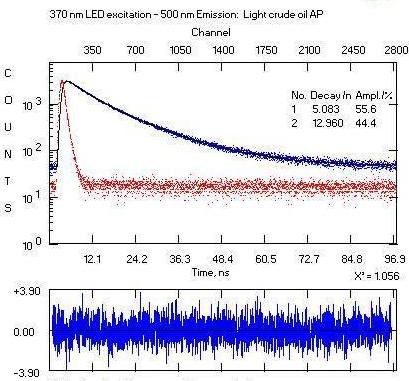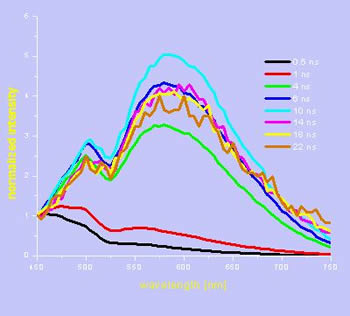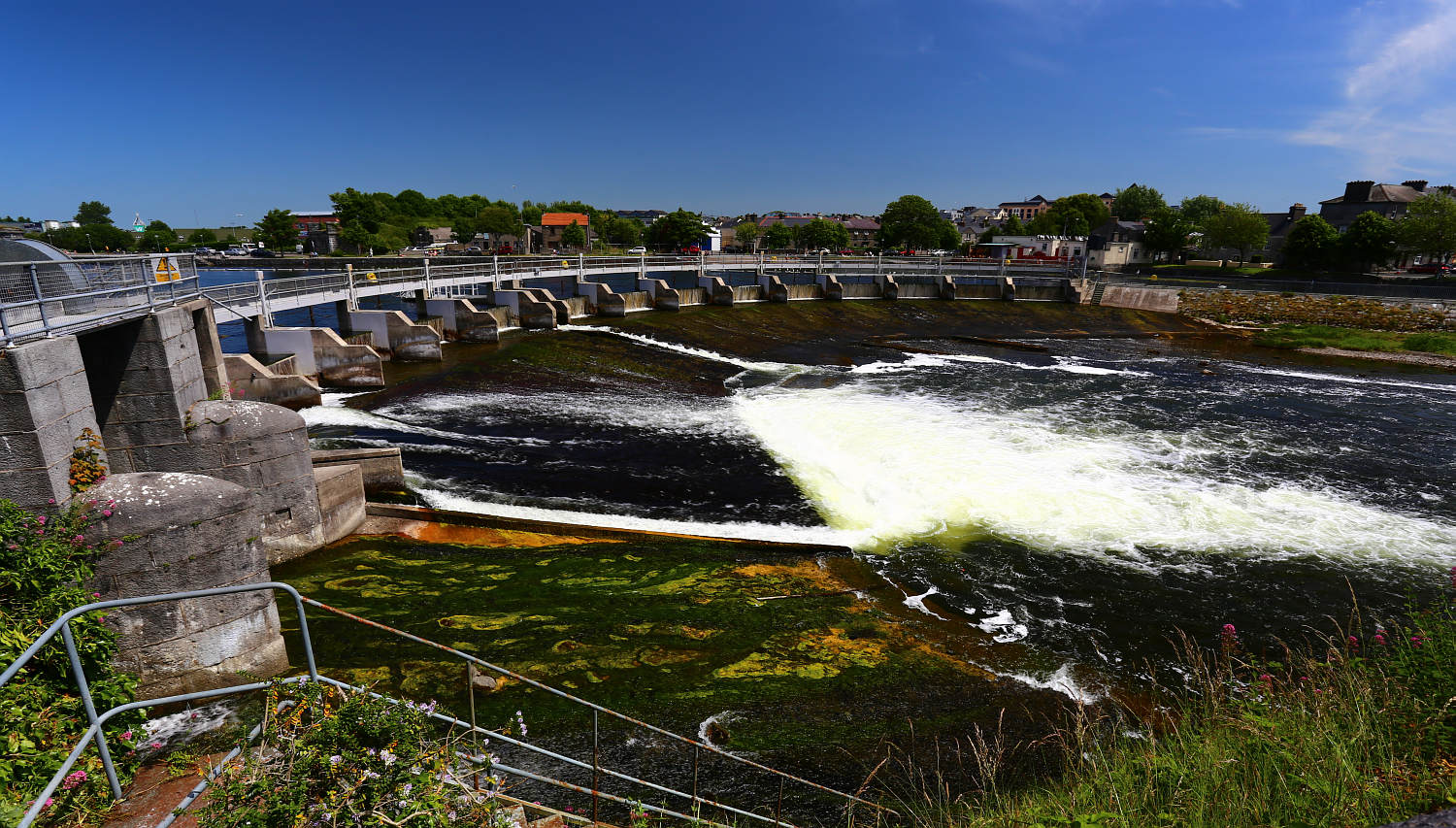-
Courses

Courses
Choosing a course is one of the most important decisions you'll ever make! View our courses and see what our students and lecturers have to say about the courses you are interested in at the links below.
-
University Life

University Life
Each year more than 4,000 choose University of Galway as their University of choice. Find out what life at University of Galway is all about here.
-
About University of Galway

About University of Galway
Since 1845, University of Galway has been sharing the highest quality teaching and research with Ireland and the world. Find out what makes our University so special – from our distinguished history to the latest news and campus developments.
-
Colleges & Schools

Colleges & Schools
University of Galway has earned international recognition as a research-led university with a commitment to top quality teaching across a range of key areas of expertise.
-
Research & Innovation

Research & Innovation
University of Galway’s vibrant research community take on some of the most pressing challenges of our times.
-
Business & Industry

Guiding Breakthrough Research at University of Galway
We explore and facilitate commercial opportunities for the research community at University of Galway, as well as facilitating industry partnership.
-
Alumni & Friends

Alumni & Friends
There are 128,000 University of Galway alumni worldwide. Stay connected to your alumni community! Join our social networks and update your details online.
-
Community Engagement

Community Engagement
At University of Galway, we believe that the best learning takes place when you apply what you learn in a real world context. That's why many of our courses include work placements or community projects.
Petroleum
Fluorescence Spectroscopy of Petroleum fluids.
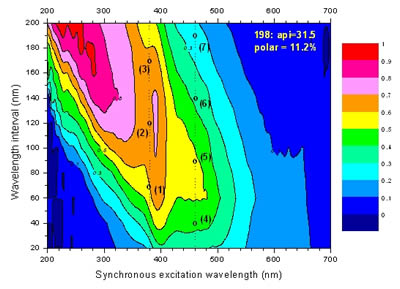 |
Research:
The primary goal of the research was concerned with developing quantitative fluorescence based techniques for the non-contact, non-destructive analysis of crude petroleum oils. The research work is split into the fluorescence analysis of bulk petroleum oils and the development of instrumentation for the analysis of microscopic hydrocarbon bearing fluid inclusions.
Past Projects:
We have in the past conducted g a range of studies on crude petroleum oils which included:
- Using fluorescence lifetimes to develop quantitative analytical methods for crude oil characterisation.
- Low temperature measurements of crude oil fluorescence.
- Developing phase-modulation based lifetime measurements of crude oils.
- Applying these methods to the analysis of refined petroleum products.
- Time resolved Emission Spectroscopy (TRES) studies of crude oils, to better understand the photophysics of complex systems.
- Evaluating TSFS as a method for characterizing oils..
|
|
A TSFS plot of a medium crude petroleum oil from the North Sea. This study also led directly to our Bioanalytical reserach programmes.....just a different type of complex fluorescing sample. |
Selected Results:
Our initial focus in this work was to investigate the possibility of using fluorescence lifetime measurements to study crude oils. In particular we have been looking for robust correlations between lifetime measurements and compositional parameters such as API gravity and polar/alkane/aromatic fractions.
|
|
| Fluorescence lifetime measurement of a light crude oil (API gravity of 36 degrees). A 370 nm GaN LED pulsed at 10 MHz (~20 µW) was used as the excitation source, with the emission being measured at 500 nm. This allowed a count rate of 2 kHz from this weakly fluorescing oil. The red trace is the instrument response function (0.77 ns) and the navy blue trace is the fluorescence decay. The decay curve was fitted to a dual exponential with an average lifetime of 10.4 ns. The residuals trace (at bottom) is evenly distributed about zero indicating a perfect fit. |
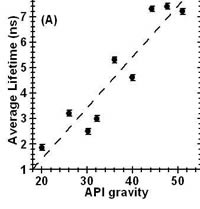 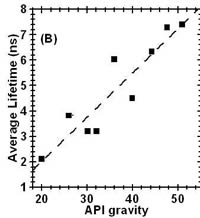 |
| The two plots above show how the average fluorescence lifetimes of crude petroleum oils from the North Sea are related to API gravity. In general as crude oils get lighter (higher API gravity) the fluorescence lifetime increases because there are lower rates of quenching and energy transfer. This happens because the fluorophores (usually aromatic polycyclic hydrocarbons) are diluted by the higher alkane fraction in light oils. Plot (a) used a 460 nm pulsed LED as the excitation source and the emission was measured at 550 nm. Plot (b) used a 510 nm pulsed LED as the excitation source and the emission was measured at 600 nm. |
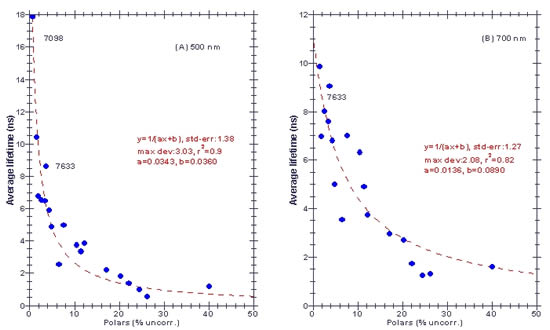
The plot above shows the influence of polar concentration on fluorescence lifetime at two different emission wavelengths, using 380 nm LED excitation. This data was acquired from a very diverse set of crude oils from 13 different geographical locations.
Time-resolved fluorescence spectroscopic study of crude petroleum oils: influence of chemical composition. A.G. Ryder. Applied Spectroscopy , 58(5), 613-623, 2004.
DLFLM Results: We characterized a range of crude petroleum oils using the DLFLM system with a 400 nm excitation source. The following plots are examples of the data that can be acquired with this system.
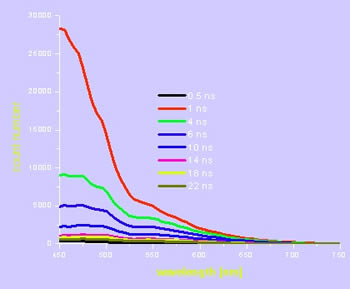 |
We have also looked at the Time Resolved Emission Spectrum (TRES) of petroleum oils. The TRES spectrum provides a wealth of information, which can be used to help understand the complex fluorescence behaviour of crude petroleum oils. The plot on the left is the TRES spectrum of a crude oil which has an API gravity of ~36, an aromatic content of 21%, and a sulphur concentration of 0.1%. The large decrease in emission intensity with time is due to the complex energy transfer and quenching processes, which are the determining factors in crude oil fluorescence. |
|
The plot on the right is another TRES spectrum in which the plots have been normalizednormalised to the fluorescence intensity at 450 nm. This helps to visualize the wavelength variation in the TRES spectra, which is linked to the distribution of fluorophores within the oil. |
|
Publications & Conference Presentations:
- Low temperature Fluorescence Study of Crude Petroleum Oils. P. Owens and A.G. Ryder, Energy & Fuels, 25(11), 5022-5032, (2011).
DOI: 10.1021/ef201030t - Frequency Domain Fluorescence Lifetime Study of Crude Petroleum Oils. P. Owens, A.G. Ryder, and N.J.F. Blamey. Journal of Fluorescence, 18(5), 997-1006, (2008).
DOI: 10.1007/s10895-008-0330-5 - Comparison of the fluorescence behaviour of a biocrude oil and crude petroleum oils. A.K. Sarma and A.G. Ryder, Energy & Fuels, 20(2), 783-785, (2006).
DOI: 10.1021/ef050294f - Analysis of crude petroleum oils using fluorescence spectroscopy. A. G. Ryder, Reviews in Fluorescence, ISBN: 0-387-23628-7, 169-198, (2005) [invited review,].
DOI: 10.1007/0-387-23690-2_8 - Analysis of hydrocarbon bearing fluid inclusions (HCFI) using time-resolved fluorescence spectroscopy. M. A. Przyjalgowski, A. G. Ryder, M. Feely, and T. J. Glynn. Proc SPIE – Int. Soc. Opt. Eng., 5826, 173-184, (2005).
DOI: 10.1117/12.605035 - Time-resolved fluorescence microspectroscopy for characterizing crude oils in bulk and hydrocarbon bearing fluid inclusions. A.G. Ryder, M.A. Przyjalgowski, M. Feely, B. Szczupak, and T.J Glynn, Applied Spectroscopy , 58(9), 1106-1115, (2004).
DOI: 10.1366/0003702041959505 - Time-resolved fluorescence spectroscopic study of crude petroleum oils: influence of chemical composition. A.G. Ryder. Applied Spectroscopy 58(5), 613-623, (2004).
DOI: 10.1366/000370204774103462 - Assessing the Maturity of Crude Petroleum Oils Using Total Synchronous Fluorescence Scan Spectra. A.G. Ryder. Journal of Fluorescence, 14(1), 99-104, (2004). DOI: 10.1023/B:JOFL.0000014667.62333.eb
- Influence of chemical composition on the fluorescence lifetimes of crude petroleum oils. A.G. Ryder, T.J. Glynn, and M. Feely. Proc SPIE – Int. Soc. Opt. Eng., 4876, 1188-1195, (2003).
DOI: 10.1117/12.463915 - Quantitative analysis of crude oils by fluorescence lifetime and steady state measurements using 380 nm excitation. A.G. Ryder, Applied Spectroscopy, 56(1), 107-116, (2002).
DOI: 10.1366/0003702021954287 - Characterization of crude oils using fluorescence lifetime data. A.G. Ryder, T.J. Glynn, M. Feely, A.J.G. Barwise. Spectrochimica Acta Part (A): Molecular and Biomolecular spectroscopy, 58(5), 1025-1038, (2002).
DOI: 10.1016/S1386-1425(01)00579-0
Other Articles & published abstracts:
- Application of multi-frequency phase and modulation fluorometry to lifetime analysis of petroleum oils. P. Owens, N.J.F. Blamey, and A.G. Ryder. InFocus Magazine, 5(March), 88-89, (2007).
- Light Emissions from Oil: A valuable Information source for petroleum analysis. A.G. Ryder, P. Iwanski, and L. Montanari, TPoint, #2-June, 9-14, (2004). [ pdf version] [ Download full issue here]
- Towards non-destructive characterization of hydrocarbon bearing fluid inclusions using time-resolved fluorescence (TRF) microscopy. M.A. Przyjalgowski, A.G. Ryder, M. Feely, and T.J. Glynn, Irish Journal of Earth Sciences, 22, 71, (2004).
- Fingerprinting of Crude Petroleum Oils in Bulk form and in Fluid Inclusions, using Time-Resolved Fluorescence Microscopy. M. Przyjalgowski, A.G. Ryder, M. Feely , and T.J. Glynn. Irish Journal of Earth Sciences, 21, 160, (2003).
- Time-resolved fluorescence spectroscopy of petroleum oils. A.G. Ryder, E. Murray-Hayden, M. Przyjalgowski, M. Feely & T.J. Glynn. Ancient Biomolecules, 4(3), 94-95, (2002).
Presentations:
- Dynamics of crude oil fluorescence revealed by low temperature time-resolved single photon counting studies. P. Owens & A.G. Ryder. XXII IUPAC Symposium on Photochemistry, Gotenburg, Sweden, 28 July – 01Aug. 2008.
- Frequency Domain Fluorescence Lifetime Study of Crude Petroleum Oils. P. Owens, A.G. Ryder, and N.J.F. Blamey. 10 th Conference on Methods and Applications of Fluorescence: Spectroscopy, Imaging and Probes, Salzburg , Austria , 9-12 Sept., 2007.
- Fluorescence lifetime analysis of single hydrocarbon-bearing fluid inclusions – a paragenetic perspective. N. J.F. Blamey, A.G. Ryder, M. Feely, and P. Owens. 23 rd International Meeting on Organic Geochemistry (IMOG), Torquay , UK , 9 -14 Sept., 2007. [Abstract available here]
- Single hydrocarbon-bearing fluid inclusion analysis using fluorescence lifetime measurements in the frequency domain. A.G. Ryder, N.J.F. Blamey, P. Owens, and M. Feely. Microscopical Society of Ireland 's 31 st Annual Symposium, University of Limerick , Ireland, 22-24 Aug., 2007.
- Fluorescence lifetime measurements of single hydrocarbon-bearing fluid inclusions. N.J.F. Blamey, A.G. Ryder, P. Owens, M. Feely, and J.F. Naranjo-Vesga. (ECROFI-XIX) European Current Research on Fluid Inclusions, Bern , Switzerland , 17-20, July, 2007.
- Analysis of Crude Petroleum Oils using Frequency Domain Fluorescence Lifetime Measurements. P.Owens, A. Ryder, and N. Blamey. 59th Irish Universities Chemistry Colloquium, Dublin City University, 13-15 June, 2007.
- Fluorescence lifetime study on crude petroleum oils using the frequency domain technique. P. Owens, A. G. Ryder, and N. Blamey, 50th Annual Irish Geological Research Meeting, University of Ulster , Coleraine, 23-25 Feb., 2007.
- Application of multi-frequency phase and modulation fluorometry to lifetime analysis of petroleum oils. P. Owens, N.J.F. Blamey, and A.G. Ryder. Microscopical Society of Ireland's 30th Annual Symposium, NUI-Galway, 30th Aug.-1st Sept., 2006.
- Nanoscale Biophotonics: oil & fluid inclusions, a case of geological biophotonics? A.G. Ryder, 4th Stokes Summer School, Skreen, Co. Sligo, Ireland, 18-22 June, 2004.
- Time-resolved fluorescence spectroscopy for characterising crude oils in bulk and fluid inclusions. A.G. Ryder, M. Przyjalgowski, M. Feely, T.J. Glynn. IMOG (International Meeting of Organic Geochemists) 2003, Krakow, Poland, Sept. 8-12, 2003.
- Assessing the Maturity of Crude Petroleum Oils Using Total Synchronous Fluorescence Scan Spectra. A. G. Ryder. 8th Conference on Methods and Applications of Fluorescence: Spectroscopy, Imaging, and Probes, Prague, August 24-27, 2003.
- Fingerprinting of Crude Petroleum Oils in Bulk form and in Fluid Inclusions, using Time-Resolved Fluorescence Microscopy. M. Przyjalgowski, A.G. Ryder, M. Feely, and T.J. Glynn. 46th Annual Irish Geological Research Meeting 2003, Belfast, Feb. 21-23, 2003.
- Fluorescence lifetime (FL) measurements of crude oils: towards the in-situ characterization of oil-bearing fluid inclusions. E. Murray-Hayden, A. Ryder and M. Feely. 45th Annual Irish Geological Research Meeting 2002, Dublin, Feb. 22-24, 2002.
- Using fluorescence lifetime measurements to quantitatively characterise crude oils. A. G. Ryder, T. J. Glynn, M. Feely & E. Murray-Hayden, IMOG 2001 , Nancy, Sept. 10-14, 2001.
Collaborations:
The oils we have been studying were kindly supplied by: Robertson Research International; BP; and Statoil. We are seeking partners in Europe and US who are interested in this type of spectroscopic approach to complex fluid analysis. In particular we would like to obtain more bulk crude oils for our sample library.








